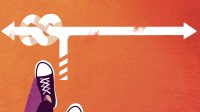What Does Good Listening Look Like?
Sitting completely still with eyes on the teacher doesn’t work for all students, but that doesn’t mean they aren’t paying attention.
Your content has been saved!
Go to My Saved Content.Imagine two students. One is constantly shifting in her seat, looking around the classroom, and spinning her pencil. Another is sitting very still with his hands folded, watching you intently. Which one would you guess is paying closer attention to your words and comprehending more of the lesson?
As a neurodivergent teacher of neurodivergent students, I’ve learned that all is not as it seems. Some students are better able to regulate their emotions and engage their minds when their bodies are free to move. This includes students who are autistic like me, as well as students with ADHD. Additionally, autistic students often find eye contact uncomfortable and listen best while looking away.
If such students must squeeze their behavior into what many teachers call whole body listening—a motionless body and controlled gaze—it could actually interfere with their concentration. Perhaps a student who seems distracted is using strategies to effectively self-regulate, while one who appears to be listening may be distracted by the need to keep up appearances.
But this doesn’t apply to all students. For some, the typical behavior of a “good listener” really does mean that they’re paying attention. So, if you can’t use movement or eye contact as a clue, how can you more accurately tell who’s listening and who isn’t?
It starts with discovering what listening looks like for individual students.
For some students, this will be easy—all you have to do is ask. You could say, “When you’re concentrating very hard, what do your eyes do? What do your hands do? What do your feet do?” A worksheet can be a great way to gather this information from students, such as the “My Way of Listening” worksheet by Awekids.
But this does require a certain level of self-awareness as well as self-acceptance. Students who are conditioned to believe that looking means listening may have trouble honestly answering a question about how they, personally, listen best.
However, there are strategies you can use to help students to figure this out.
3 Ways to Help Students Discover Their Listening Style
1. Give students freedom to experiment with ways to listen. You could start by explaining to students that you care more about what their minds are doing than what their bodies are doing. Then let them know that from now on—or, if you prefer, as an experiment for the next week—they are free to look around and move around, as long as they make a sincere effort to listen.
If you’ve embraced traditional listening styles for a long time, this may be a difficult change for you and a surprising one for your students. But I encourage you to give it a try, especially if you teach high school. (For lower grades, it may be more effective to skip right to step 2.)
2. Check for comprehension, and notice how it compares to behavior. If you already have a favorite method (or several) to confirm that students are understanding a lesson, then this step is half done! If not, here are some ideas.
- Guided Notes: Give students a worksheet on the topic you’re about to cover. Over the course of the lesson, as new concepts are introduced, students who are listening carefully will be able to fill in the blanks with the new information. This comprehension check works best during a lesson.
- Teach the Teacher: You can pretend to be a student, and ask your students to explain concepts that they recently learned. To stretch their creativity even further, pretend that you still don’t understand, and see if they can vary their explanation to present it from another angle. This comprehension check works best right after a lesson.
- Warm-Ups: I like to begin each class with a single question or exercise that’s easy for students who were paying attention the previous day. Ideally, a warm-up requires some information that students didn’t have the previous week, so its focus is more on understanding than on memory. This comprehension check works best the day right after a lesson.
As you identify each student’s level of comprehension, compare it with what they were doing during the lesson. Were they looking up, down, or all around? Were they sitting still, rocking, or wriggling? Notice what they were doing on the days when their comprehension was highest.
3. Remind your students to listen in ways that work well for them. Once you get to know your students’ listening styles, you can encourage the behaviors that help them process information. At my school, we keep a basket of fidget toys in each classroom and offer it to students whose concentration seems to be drifting. A standing desk is also an option for students who feel restless when they sit too long.
Your students may or may not have been diagnosed with disabilities that require accommodations like these, but they may still benefit from similar strategies. Understanding their listening style will help them not only participate in class but also self-advocate for their needs after graduation.
The phrase whole body listening doesn’t have to mean suppressing natural movement. If we consider the diversity of what various bodies do while listening intently, whole body listening can take on a new, inclusive meaning—truly using your whole body to help you listen well.
